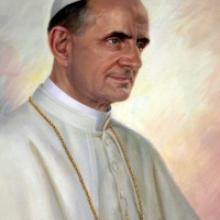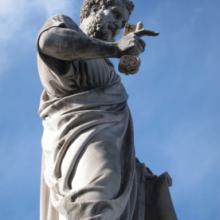pope paul vi
As he wraps up a Vatican meeting marked by sharp debates over sex and morality, Pope Francis on Oct. 19 will honor one of his most controversial predecessors by beatifying Pope Paul VI, who is most famous for reaffirming the Catholic Church’s ban on artificial contraception.
Beatification puts Paul one step shy of formal sainthood. The move might seem out of step with Francis’ pastoral approach given that Paul’s birth control ruling, in the 1968 encyclical “Humanae Vitae,” set the stage for the culture wars that overtook Catholicism after Paul died in 1978.
A wide swath of Catholics, especially in the U.S. and Europe, were furious over Paul’s decision. They were convinced that the ban would be lifted and that Paul was shutting down the reforms that had begun a few years earlier with momentous changes adopted by the Second Vatican Council.
Many conservatives, on the other hand, hailed “Humanae Vitae” for reasserting traditional doctrine, and the division foreshadowed the deep splits that have played out even in this month’s high-level synod in Rome — a polarization that Francis says he wants to overcome.
Yet Francis is trying to accomplish that goal by focusing not so much on “Humanae Vitae” but on Paul VI’s many other groundbreaking, though often overlooked, contributions:
It’s almost a year since Pope Francis was chosen as Benedict XVI’s successor. The Argentinian-born pontiff has quickly achieved global fame for his numerous statements indicating that significant changes may be coming to the Roman Catholic Church.
One possible change emerged last month when London’s Sunday Times reported that Francis wants to make public the Vatican’s archives of Pius XII’s pontificate. Eugenio Pacelli became pope in 1939 and served as pontiff during the period of World War II and the Holocaust until his death in 1958.
According to the British newspaper, Francis wants to release the Pius XII papers for study before determining whether to consider his controversial predecessor for sainthood. Francis has already “fast-tracked” the path to sainthood for John XXIII and John Paul II, but not Pius XII.
Vatican theologians have given their approval to a miracle attributed to the intercession of Pope Paul VI, moving him a step closer to sainthood.
The team of medical professionals and doctors that advise the Vatican’s Congregation for the Causes of Saints already had approved the same miracle in December. Now that a panel of theologians has signed off, the miracle only requires a review by Pope Francis to be considered official.
When that happens, Paul will be beatified — the final step before sainthood. A second miracle is typically required for canonization.
When Pope Francis cradled the small box said to contain nine bone fragments believed to be the mortal remains of St. Peter, the first pope, he fanned the flames of a long-standing debate over the authenticity of ancient church relics.
Most old churches in Italy contain some ancient relic, ranging from a glass tube said to hold the blood of St. Gennaro in Naples to a section of what is believed to be Jesus’ umbilical cord in the Basilica of St. John of Lateran in Rome. Perhaps the most famous religious relic in Italy — the Shroud of Turin, believed by many to be Jesus’ burial cloth — will go on display again in early 2015, and Turin Archbishop Cesare Nosiglia this week invited Pope Francis to attend its public debut.
But St. Peter’s bones are of particular importance, since they are the very basis — both architecturally and spiritually — for Catholicism’s most important church. And yet the bones were only discovered during a series of excavations in the 1940s, almost 1,900 years after Peter died, in either 64 or 67 A.D.
The Vatican said it would display for the first time bones believed to be the mortal remains of St. Peter, the leader of Jesus’ 12 apostles, to mark the end of the Year of Faith on Nov. 24.
Archbishop Rino Fisichella, president of the Pontifical Council for Promoting New Evangelization, wrote in Monday’s editions of L’Osservatore Romano, that the Catholic faithful making a pilgrimage to St. Peter’s tomb to mark the end of the Year of Faith will enjoy “the exposition … of the relics traditionally recognized as those of the apostle who gave his life for the Lord on this spot.”
Fisichella was referring to the long-held belief that Peter was crucified upside down and died in either A.D. 64 or 67 on the spot now marked by the Clementine Chapel inside the basilica that bears his name.

Pope Paul VI. Image via Wiki Commons, http://bit.ly/xCeHRU.
Editor's Note: The following aritcle was written in 2008, around the 40th anniversary of Humanae Vitae, the papal document that reinforced the Catholic Church's ban on artificial birth control.
Some say Pope Paul VI predicted the dangers of loosening sexual morals: widespread divorce, disease and promiscuity. Others say he cracked open a culture of dissent that has seeped into every corner of the church.
Either way, more than 40 years after Paul VI released ``Humanae Vitae'' on July 25, 1968, the papal encylical banning most forms of birth control continues to be a flashpoint in the Catholic Church.
Earlier this year, Cardinal Francis George of Chicago said Humanae Vitae set up ``a direct conflict between many people's experience ... and the authority of the church.''



![St. Peter in Prison (The Apostle Peter Kneeling). Photo courtesy Rembrandt [Public domain], via Wikimedia Commons/RNS](https://sojo.net/sites/default/files/styles/medium_square/public/blog/Rembrandt_st._peter_in_prision.jpg?itok=xFAbgqBx)
